Introduction
Profit-making organizations are established to get optimal returns to investors. In this case, the situation that is regarded as the best and the most preferred is when businesses make supernormal profits in the short and long-term. This way, investors remain assured of huge returns from their equity. However, the question of whether optimal profitability across various organizations exists is one of the fundamental issues that economists endeavor to unveil its answer.
Within the sphere of business economics, the basic assumption is that firms normally set their goals, objectives, and aims in a manner that closely profiles their profit-maximization plans (Hitt, Ireland & Hoskisson 2013). Some of the perspectives that influence the economics of an industry predominantly focus on the concept of profit maximization. In other words, economists look for competitive strategies that can guarantee all-time profitable operations.
Nonetheless, some firms’ profitability varies depending on the prevailing characteristics of their operational environments. For example, as revealed in this paper through diagrams, a monopolistic firm can earn abnormal profits in both the short-run and long-term because of its capacity to continuously devise strategies for convincing clients to pay premium rates, despite the existence of competing for merchandise in the market. The paper also argues that another business operating under the condition of perfect competition makes supernormal returns in the short-run following the absence of competition and normal proceeds in the long term after rival businesses introduce analogous items for sale.
Background
Monopolistic Firms
A pure monopolistic market involves one company or an organization dominating the supply of a product. Good examples of monopolistic operations include Microsoft Company’s early dominance in the supply of operating systems and a situation where a government has the sole responsibility of offering a given service. Even though monopolies rarely exist in their pure forms, their main trait is that they improvise market rates without paying attention to the probability of any competition (Azevedo & Gottlieb 2017).
A company acquires a monopolistic power of market control when close substitutes do not exist, or its products are differentiated. Monopolies maintain market supremacy by taking advantage of economic barriers (Adumyian 2013). For example, in the case of Microsoft, when many operating systems (OS) are accessible in the market and that consumers have made high investments in software and hardware components, which can only use a specific OS, they are hindered from switching to another alternative. In this case, monopolies prevail by establishing obstacles that prevent new competitors from venturing into a market.
Businesses under Perfect Competition Conditions
Firms that operate under perfect competition rarely exist. However, the available ones function in very large bazaars, including agricultural, foreign exchange, and stock markets. Perfect competition occurs in markets where several firms supply a product or homogenous and standardized merchandise. It also requires the market to be characterized by the low exit and entry costs where the prevailing supplies can only be traded at the set rates while having zero influence on market charges.
The established barriers to entry and exit suggest that some suppliers will be limited from offering homogenous or consistent commodities in the market (Chang 2017). In a perfectly competitive market, many producers avail merchandise subject to the condition that the average total cost associated with supplies is lower compared to the market price. Pure monopoly requires steep barriers to entry. Otherwise, an oligopoly may emerge. When entry barriers are minimal or absent, monopolistic competition exists.
Abnormal (Supernormal) and Normal Profits
Companies may record anomalous or ordinary returns based on the configuration of their respective zones of operation. Supernormal or abnormal profits refer to the proceeds “of a firm over and above what provides its owners with a normal (market equilibrium) return to capital” (Kopel, Lamantia & Szidarovszky 2014, p. 395). Ordinary or normal profits imply the opportunity cost of a proprietor’s resources.
A theoretical model of perfect market competition asserts that firms cannot make nonstandard returns sustainably for long (Bischi, Lamantia & Radi 2015). When other companies realize the concept that particular merchandise can yield anomalous returns, they introduce close substitutes or analogous products. Since no entry obstacles are available in perfect competition settings, an abnormal profit entails an important incentive that results in excessive supplies (Domenico & Lamantia 2016).
Eventually, prices fall, thus eliminating supernormal returns. However, in an imperfect competition such as the case of pure monopoly or oligopoly, nonstandard proceeds may be sustained in the end when firms successfully block the entry of other rivals in a specific market. The next section explains the economic reasoning behind the inability of firms operating under perfect competition settings to realize abnormal profits in the long term whereas monopolistic businesses can effectively make such returns in both the short and long run.
A Monopolistic Business’ Abnormal Profits in both the Short and Long Run
Monopolies have the advantage of economies of scale, a situation that results from the decreasing average total cost (ATC) and the corresponding rise in the quantity required. Bearing in mind that all institutions have various predetermined overheads, the average total charge goes down with an increasing capacity of supply since firms can allocate preset costs to many commodities (Ferrer 2013). However, as the limit for fixed expenses nears, the ATC goes up.
Consequently, when the ATC goes down following a rise in the capacity required, one firm dominates the market since other companies fail to reach the levels acquired by dominant institutions. A declined in the ATC across an entire bazaar leads to the emergence of a natural monopoly (Chang 2017). Graph 1 shows an ATC diagram for a natural monopoly and a competitive business.
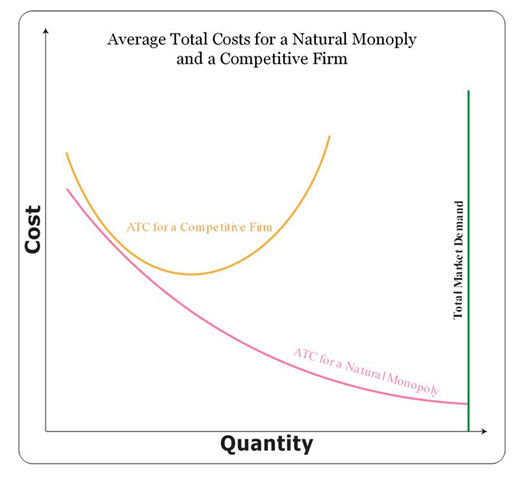
From the above illustration, a competitive institution requires substantial investments in fixed assets to augment its manufacturing capacities beyond a particular level. This condition reveals why an ATC curve begins to ascend after reaching a particular minimum limit, which encompasses the state at which the highest turnover can be made in the short-run (Yacob & Allen 2017). For example, a car manufacturer such as Toyota can only produce a particular number of cars, beyond which its manufacturing limit is exceeded, thus compelling it to invest in more fixed assets, including production equipment, if it must boost its production capability.
For a monopolistic company such as Microsoft, specifically, its case of Operating Systems (OS), any number of units can be produced without investing in other fixed assets or requiring it to incur considerable supplementary costs. Such a company deploys strategies that include “patenting, predatory pricing, and company rights to discourage competition” (Chirco, Colombo & Scrimitore 2013, p. 57).
These efforts allow the business to earn supernormal proceeds in the short and long run. Graph 2 demonstrates this possibility. From the diagram, profit maximization is realized at the point where marginal revenues (MR) coincide with marginal costs (MC). In other words, equilibrium occurs at point M where Qm meets Pm. The diagram demonstrates how a monopoly can record supernormal proceeds since the price AR is higher compared to AC.
While this situation occurs in the short run, more institutions end up venturing into the market with time. However, entry obstacles forbid them to the extent that a monopoly continues recording supernormal returns even in the long term. Therefore, the short-run diagram of the relationship between the price, marginal revenues, and the quantity supplied also prevails even in the long term.

Why a Business under Perfect Competition Conditions Only Makes Supernormal Profits in the Short Run and Normal Profits in the Long Term
Competitors have developed long-term products with a utility similar to that developed by a firm, which dominates a new market. Such a strategic decision occurs due to the incentive of earning abnormal or supernormal profits that were previously enjoyed by the nominating institution. Soon after many competitors introduce more products, customers have the choice of buying from many suppliers depending on who has the best price offer.
Therefore, no single company can set a fixed fee for its product. Shostak (2018) supports this assertion by informing that institutions operating in a perfectly competitive market cannot control prices. Rather, they only respond to variations in prices following changes in demand. Here, they either supply more or less depending on whether they can sell at levels above their breakeven point. This situation paves the way for an institution operating under perfect competition to only enjoy normal profits in the long term.
Suppliers do not have to sell at lower prices relative to the market rate since they can trade all the quantity supplied at the prevailing fee as long as a firm’s demand in its market share has not been exhausted. In case one supplier chooses to raise the price, consumers respond by purchasing from other suppliers (Kuksov, Ashutosh & Mohammad 2017). Unlike a corporation operating in a monopolistic market, this condition eliminates the possibility of a company operating in a perfectively competitive market enjoying supernormal proceeds in the long term (Thiel 2014).
Graph 3 demonstrates that under perfectly competitive conditions, industry experiences an increasing supply that matches the growing price. However, increasing prices leads to a reduction in market demand. In the situation where commodities supplied are differentiated in some respect, the market becomes a monopoly. This situation permits suppliers to charge higher rates subject to the availability of a mechanism such as advertising to convince customers to purchase some manufactured goods. Therefore, it can continue to enjoy supernormal profits even in the long term.
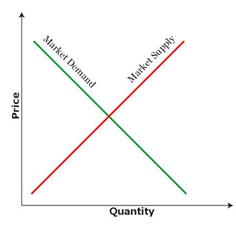
For every individual institution, demand is usually perfectly inelastic to the extent that a highly competitive firm supplies any quantity of a product, with the market price remaining constant. As shown in Graph 4, maximizing returns occur after availing quantities at marginal charges. According to Manesh and Karimani (2017, p. 417), this situation occurs when “the cost of producing an additional product is equal to the market price.”
Considering that it is only in the short term that businesses can earn abnormal profits, it becomes important for firms to take full advantage of returns before rival companies join the bazaar, a situation that leads to lower prices and returns. In this case, normal profits prevail in the market. This goal can be accomplished through the total revenue and total cost approach as shown in Graph 5 or by ensuring that a firm increases its output until it reaches a level where the marginal revenue (MR) corresponds to the marginal cost (MC) as shown in Graph 6.
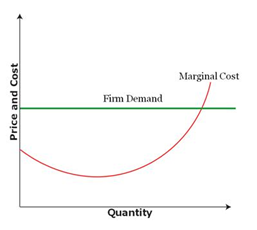
From Graph 5, the first breakeven point occurs when the total cost matches the overall revenue. From this point, business begins to make a profit, which is maximized at the point where the overall charge curve is at its lowest limit (point 3). The corresponding quantity at this point entails the optimal supply capacity of a business beyond, which additional product deliveries require a company to invest in fixed assets, including machinery and human resources. Such fees rise to the extent that the total cost curve crosses the overall revenue line again, thus introducing a second breakeven point (point 2).
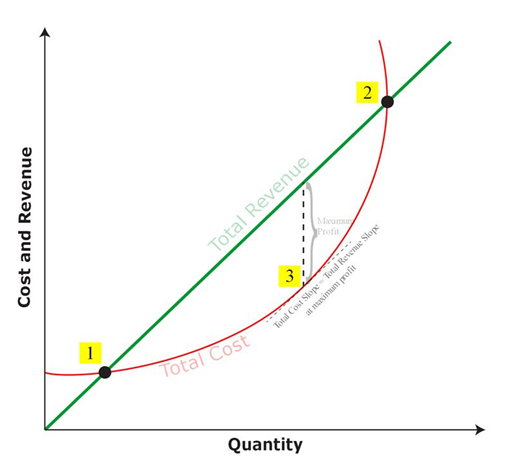
From Graph 6, when market prices fall below the ATC, businesses operating under perfectly competitive conditions do not attain returns. However, Manesh and Karimani (2017, p. 419) assert, “If prices are higher than the minimum AVC, firms can minimize losses since the amount of marginal revenue exceeds the variable rate, which can be used to lower the amount incurred from fixed costs.” A shutdown level occurs in case of prices fall below the minimum AVC.
From Graph 6, a portion of the MC curve beyond which shutdown is not witnessed defines the short-term supply line for companies in a completely aggressive market. No company dares to produce below the shutdown level since marginal revenue falls below the average fixed charge. Between the breakeven point and the shutdown level, a company operating under perfectly competitive conditions still enjoys returns since marginal revenue is above the AVC. However, it has to cut down the number of losses. At the breakeven point, it makes normal proceeds. Indeed, in the long term, companies only operate at prices that are just slightly above the breakeven limit because increasing the price may cause clients to buy from competitors.

A company operating under perfect competition conditions can make abnormal proceeds. This situation is only possible for a firm that is introducing a new commodity in a competition-free market. In the short term, when a firm has no rival products, it balances its supply and demand while charging an optimal price for its items to the extent that it enjoys abnormal returns as shown in Graph 7. Customers have no option other than paying top prices for items (Amaldoss 2017). From Graph 7, such revenue is only made when companies sell in the short run at prices well above the breakeven level with no fear of competition.
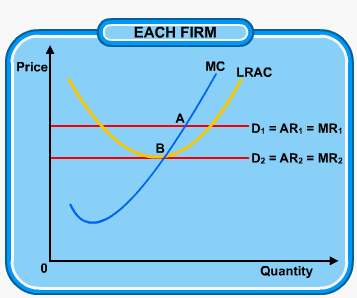
The situation of enjoying high returns in the short-run is altered in the long term when supernormal profits signal competitors to introduce their products to the perfectly competitive market. From Graph 8, the initial short-run price is P1 since demand (D1) and supply (S1) meet at C. Hence, for each company in the market, the MC=MR1, which is defined by point A. Supernormal or abnormal returns are realized. However, when competition plunges in, excess supplies occur. This shifting occurs until P2 is reached. At this level, prices fall. Abnormal profits are eroded. Similarly, no incentive is introduced for new firms to venture into the market. Therefore, in the long-term, for a firm operating under perfectly competitive conditions, it is practically impossible to earn supernormal profits unlike the case of monopolistic firms.
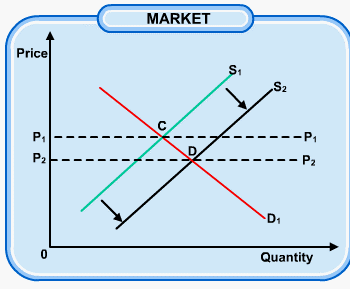
Conclusion
Firms operating under perfectly competitive conditions offer homogenous merchandise in the marketplace. In the short term, they may be supplying a product without any form of competition. Here, they can charge higher prices to enjoy top profit margins. However, this situation does not prevail for a long time since abnormal profits made attract other suppliers whereby the supply now exceeds the demand, hence forcing prices to go down. Indeed, the firm that first introduced the product cannot sell it at a high price since consumers may shift to other suppliers unless it differentiates the item.
However, the company starts to operate as a monopoly. Therefore, in the long term, it can only earn normal profits if operating in perfectly competitive conditions. Nevertheless, monopolies can make abnormal profits in both the short and long term since they differentiate their products. They also look for mechanisms for convincing customers to pay higher prices amid the existence of competing products. They also look for strategies for increasing market entry obstacles.
Reference List
Adumyian, K 2013, Monopolies in Armenia, Hrayr Maroukhian Foundation, Yerevan.
Amaldoss, W 2017, ‘Reference-dependent utility, product variety, and price competition’, Management Science, vol. 3, no. 2, pp. 1-15.
Azevedo, E & Gottlieb, D 2017, ‘Perfect competition in markets with adverse selection’, Journal of the Econometric Society, vol. 85, no. 1, pp. 67-105.
Boschi, G, Lamantia, F & Radi, D 2015, ‘An evolutionary Cournot model with limited market knowledge’, Journal of Economic Behaviourand Organisation, vol. 116, no. 3, pp. 219-238.
Chang, J 2017, ‘EBay: towards a perfectly competitive market’, International Journal of Economics and Business Research, vol. 9, no. 3, pp. 65-70.
Chirco, A, Colombo, C & Scrimitore, M 2013, ‘Quantity competition, endogenous motives and behavioural heterogeneity’, TheoryandDecision, vol. 74, no.1, pp. 55-74.
Domenico, D & Lamantia, F 2016, ‘Control delegation, information and beliefs in evolutionary oligopolies’, Journal of Evolutionary Economics, vol. 26, no. 5, pp. 1089-1116.
Ferrer, C 2013 ‘Oligopsony-Oligopoly the perfect imperfect competition’, Procedia Economics and Finance, vol. 5, no. 1, pp. 269-278.
Hitt, M, Ireland, D & Hoskisson, R 2013, Strategic management: concepts and cases: competitiveness and globalisation, 10th edn, South-Western Cengage Learning, Mason, OH.
Kopel, M, Lamantia, F & Szidarovszky, F 2014, ‘Evolutionary competition in a mixed market with socially concerned firms’, Journal of Economic DynamicsandControl, vol. 48, no. 3, pp. 394-409.
Kuksov, D, Ashutosh, P & Mohammad, Z 2017, ‘In–store advertising by competitors’, Marketing Science, vol. 36, no. 3, pp. 402-425.
Manesh, S & Karimani, F 2017, ‘Differences between monopoly and perfect competition in providing public transportation (case study: lane no. 10 and 96 of Mashhad bus system)’, International Journal of Economic Management Science, vol. 6, no. 3, pp. 416-424.
Shostak, F 2018, Why perfect competition is not so perfect. Web.
Thiel, P 2014, Competition is for losers. Web.
Yacob, Z & Allen, F 2017, ‘Empirical analysis of profit maximisation and cost minimisation behaviour of Kansas farms’, Applied Economics Letters, vol. 24, no.17, pp. 1255-1258.